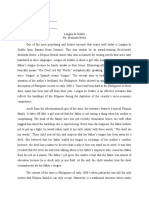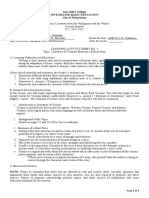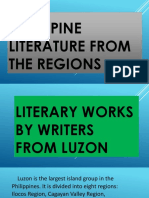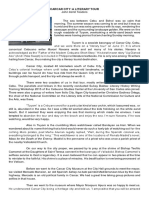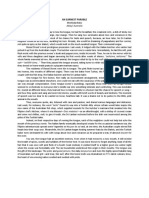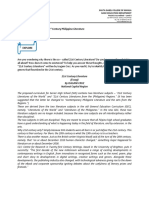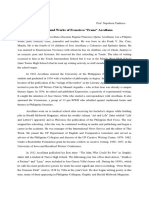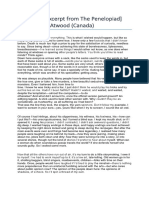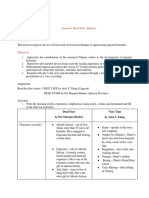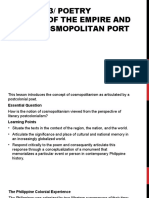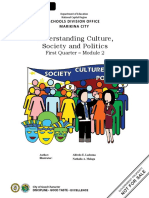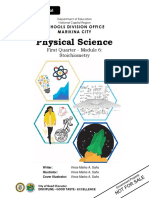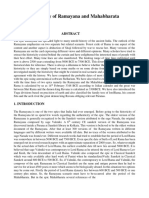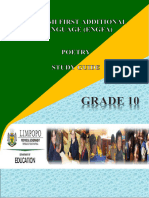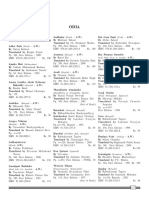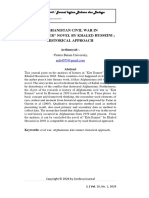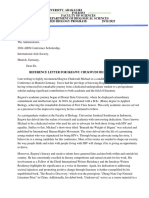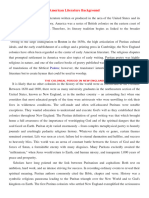FINAL COPY SHS 21st Century Literature Q1 M2
FINAL COPY SHS 21st Century Literature Q1 M2
Uploaded by
Lee Arne BarayugaCopyright:
Available Formats
FINAL COPY SHS 21st Century Literature Q1 M2
FINAL COPY SHS 21st Century Literature Q1 M2
Uploaded by
Lee Arne BarayugaOriginal Title
Copyright
Available Formats
Share this document
Did you find this document useful?
Is this content inappropriate?
Copyright:
Available Formats
FINAL COPY SHS 21st Century Literature Q1 M2
FINAL COPY SHS 21st Century Literature Q1 M2
Uploaded by
Lee Arne BarayugaCopyright:
Available Formats
Department of Education
National Capital Region
SHS S CHOOLS DIVIS ION OFFICE
MARIK INA CITY
21st Century Literature from the
Philippines and the World
First Quarter – Module 2
Elements and Contexts of 21st
Century Philippine Literature from the Regions
Writer: Roger M. Calayo
Illustrator: Marexcza Z. Salinas
Layout Artist: Richland C. Buere
City of Good Character 1
DISCIPLINE • GOOD TASTE • EXCELLENCE
What I Need to Know
This module gives you samples of literary pieces from the different regions. The
samples vary from poetry, short story, to essay. It is in the mind of the author to give
you some insight on how the way people raised reflects on their work. The region where
a particular author grew, especially the language and traditions were taken into
consideration.
At the end of the lesson, the students are expected to compare and contrast the
various 21st century literary genres and the ones from the earlier genres/periods citing
their elements, structures, and traditions (EN12Lit-Id-25).
Specific Learning Objectives
In this lesson, you will learn to:
1. analyze selected literary works by writers from Luzon, Visayas, and Mindanao;
2. identify the context of a given literary text;
3. relate the context of a literary text to its meaning; and
4. situate the literary text in the context of the region where the writer is from
and of the nation.
What I Know
Choose the letter of the best answer. Write the chosen letter on a separate sheet
of paper.
1. What do you call the sound device that refers to words or phrases with harsh
sounds that create disturbing tone?
a. Alliteration
b. Assonance
c. Cacophony
d. Euphony
2. What do you call the sound device that refers to words or phrases with melodic
sounds that create calming tone?
a. Alliteration
b. Assonance
c. Cacophony
d. Euphony
City of Good Character 1
DISCIPLINE • GOOD TASTE • EXCELLENCE
3. What is the literary element that talks about a unique way of expressing
oneself?
a. Humor
b. Image
c. Style
d. Tone
4. What is the literary element that talks about an attitude being conveyed by the
language used by the writer?
a. Humor
b. Meter
c. Style
d. Tone
5. What is the literary element that talks about a general idea, often about human
experience, which in the end wants to share to the audience?
a. Image
b. Meter
c. Sense
d. theme
Elements and Contexts of 21st
Lesson
Century Philippine Literature from
1
the Regions
The Philippines has a unique cultural landscape, one shaped by many dialects
and traditions determined by their geographical location and linguistic formation. It
cannot be rightly said that there is just one Filipino culture because there are so many
different cultures in our country. These different cultures brought about by their
differences in origin come together to create a colorful Filipino culture.
What’s In
What goes around in the mind of the author while this module is being crafted is
to let the reader be aware of the different wonderful pieces of literature all throughout
the nation. Lest that we know, there are numerous literary pieces that are world-class
but not able to reach the comfort of each Filipino reader. Each region has entries in this
module. Each reader will be given the chance to have a taste of what the selected region
has to offer. The ones that are printed here may not be the best but surely will suffice
the reader’s literary cravings.
City of Good Character 2
DISCIPLINE • GOOD TASTE • EXCELLENCE
What’s New
Bicol Literature
A good number of Bikolanos are multilingual and are normally proficient not only
in their native tongue but also in English and Filipino. Prominent writers such as screen
writer Ricky Lee and poet Marne Kilates are both natives of Bicol.
As of this time, there are proverbs, riddles, and sayings that have remained in
use, such as “An matakot sa doron, Daing aanihon” in English, “Those afraid of locusts,
Will not harvest anything”. There is also a tradition of Tigsikan, or a game of creating
witty, versified extemporaneous toasts during a round of drinking.
Bicol writers have adopted forms of literature for their own enjoyment. There are
many corridos and religious works, coming from the press owned by Mariano Perfecto.
These eventually led to the creation and enjoyment of other forms of entertainment,
such as comedia and the zarzuela, in the 1800’s and early 1900’s. There are works in
Bicol during this time, as there were Bicol-based publications, and the production of
poems and fiction grew. Literary production continued via varied publications until the
1960s when the last Bicol magazine stopped production.
MAYON
By: Kristian Sendon Cordero
Camarines Sur
Ayon sa alamat, lason ng pana ni Pagtuga,
Ang lumikha sa bulkan – libingan ito
Ng dalagang namatay sa isang digmaan.
Ngayon, ano ang tutubo sa paanan ng Mayon
Gayong nagiging malawak na itong sementeryo
Ng abo, ng tao. Manganganak na kaya ito?
Tinitigan ko ang nakangangang bulkan – binabalot
Ng ulap at ng sariling usok ang tuktok, gatas sa labi,
Baka sakali, magpakita, nang may silbi ang kamera.
Sa ilang retrato na ibenebenta ng mga bata sa Cagsawa
Lusaw na tae ang nagliliyab na lava, dumadaloy pababa.
Matandang nag-nganganga ayon naman sa isang makata.
Sa isang lumang postcard na nakita ko sa isang antigong Merkado-
Kapag sa malayo, isa siyang magandang sekyung nakatanod,
Handa sa pagkapkap, naghihintay sa iyong pagpasok.
City of Good Character 3
DISCIPLINE • GOOD TASTE • EXCELLENCE
Activity: Respond critically to the following questions.
1. According to the poem, what led to the creation of the volcano?
2. In the second stanza, how is the area around the foot of Mayon being described?
3. What is the persona in the poem waiting for in the third stanza?
4. List at least three images found in the poem. Cite the lines where they appear.
5. State the dominant physical sense being used by the poem to create images you
listed in the previous question.
6. Examine the images in the poem and determine whether the impression being
conveyed by the image is positive or negative.
7. The first stanza of the poem showcases the death of Magayon as the cause of the
birth of the volcano. Carrying this reasoning through to the second stanza, what
is the persona implying with his use of the image of a graveyard?
8. The fourth stanza presents an image of the poem which was viewed differently by
two different people – the persona and the unnamed poet, or makata – who gave
a very different interpretation of the image. Defend the choices of both poets in
light of how Mount Mayon is seen in the poem.
Discuss why the author used a security guard as the final image of the poem.
What does this seem to imply about how security personnel are viewed?
What is It
Meter is a unit of rhythm in poetry, the pattern of the beats. It is also called a
foot. Each foot has a certain number of syllables in it, usually two or three syllables.
The difference in types of meter is which syllables are accented and which are not. A
poem requires that there be an image presented to the reader. Images need to be visual.
A poem will not limit itself only to visual images but will use other senses. The presence
of figurative language such as simile, metaphor, personification, hyperbole, metonymy,
etc. should be present. Poems possesses dramatic situation which calls for the audience
to relate to the poem emotionally. Poems possess a theme, a general idea, often about
human experience, which in the end, it wants to share to the audience.
City of Good Character 4
DISCIPLINE • GOOD TASTE • EXCELLENCE
Pampango Literature
Pampango literature is perhaps a case in point where the writers are indeed
struggling. Pampanga was the first province in Luzon to be declared by the Spaniards,
who quickly befriended the Kapampangan tribal chieftains and gave them political and
financial benefits. Kapampangan culture became heavily influenced by Spain. With the
arrival of the Americans, who established military bases in the region, the Kapampangan
again embrace foreign influences.
The effect of these influences on the literature was that, there were plenty of
Spanish works translated into Pampango, the local language; but there also was a
continuing oral tradition, one which was critical of the elite Pampango. These two
traditions existed and comingled, creating a literary landscape that used the influences
of Spain and America as well as the traditional Pampango. For example, Lino G. Dizon’s
Pasyon Ding Talapagobra used the traditional pasyon but also used the vernacular
to discuss the injustices suffered by the working-class farmers.
The initial flourishing of Kapampangan literature in the early twentieth century
would fade, as publications dedicated to this literature never seemed to take hold.
Lourdes Vidal, who discussed Kapampangan literature in Filipino Writing: Philippine
Literature from the Regions, expressed pessimism that the region would be able to
produce new work unless it sees new writers step in with a clear notion of their own
regionalism and are able to speak with clear voices to contribute to the country.
Read the essay below.
HOME OF THE ASHFALL
By: John Jack Wigley
The eruption of Mt. Pinatubo was recorded as the second largest terrestrial
eruption of the 20th Century, and the second largest eruption to affect a densely
populated area. Ash Fall, which formed a weighty, rain-drenched snow-like film, affected
almost the entire island of Luzon, and even reached the neighbouring countries like
Malaysia and Vietnam. It was further aggravated because of typhoon Yunya, which
brought with it heavy rains and strong winds. To the Kapampangans and to the people
affected by the tragedy, it would serve as a testament in their irrepressible attribute of
rising above their plight and predicament.
City of Good Character 5
DISCIPLINE • GOOD TASTE • EXCELLENCE
I was no longer living in Angeles City when Mt. Pinatubo erupted on June 15,
1991. I was promoted from being a crew member at Pizza Hut Dau to management
trainee at Pizza Hut Harrison Plaza in December 1990. After being a service crew
member for more than four years and graduating from college in 1989, I had to say
goodbye to my hometown where I lived for more than two decades. It was my first time
to work in Manila. I asked the assistance of Ed Calupitan, a fellow Pizza Hut Dau crew
member now based in Manila to help me find a place to stay. He was living in two-
bedroom apartment and gladly offered the other room for me.
Weeks before the eruption, I read several news and warning about Mt. Pinatubo.
Frankly, I never knew that there was a volcano in the Zambales mountain range. Nobody
among my Kapampangan friends did. I guess we were all clueless about the impending
danger this would cause in our lives. Later on, I realized that the summit of the volcano
was just fourteen kilometres away from the extent of Clark Air Base. I thought that
volcanoes were conspicuous mountains and had fierce-looking summits like Mayon’s
and Halcon’s. But this one was deeply hidden among the several mountains called the
“Cabusilan Mountains” of Zambales. How a volcano would manage to hide among the
mountains and be covered with a dense forest was something I couldn’t comprehend. If
it was bound to erupt, I guess it would be just like a firecracker.
Hell, I thought that if there was a mountain near us which I imagined would erupt
anytime, it would be the Arayat, which was located at the heart of Pampanga, with its
open mouth and forbidding countenance. Not this obscure mountain whose native
inhabitants, the Aetas, never even knew about.
I paid no more attention to the warnings.
I had only been in Manila for barely six months and was enjoying my new-found
independence. I would sometimes go to Angeles City to see mother during days-off,
which usually fell on a weekday since management people did not have the luxury of
day-off during weekends because it was the time when more people would go out and
eat. Pizza Hut Harrison Plaza was a high-volume unit.
That fateful day, after my opening shift, I went to see a film, it was “Hihintayin
Kita sa Langit”, a film adaptation of Bronte’s “Wuthering Heights” directed by Carlos
Siguion Reyna. The film started erstwhile lovers by Richard Gomez and Dawn Zulueta.
I was feeling all mushy and melodramatic after watching the film when, once outside, I
saw parked cars covered with what seemed like a whitish-gray blanket. And so were the
streets. Is finally snowing in Manila? I thought, as I felt some of the particles on my
hand and smudge my shirt. When I looked closely and touched them, they were grainy.
It was the ash from an ashtray.
City of Good Character 6
DISCIPLINE • GOOD TASTE • EXCELLENCE
“What has happened?” I asked the guard on duty.
“Di kop o alam ser, pero kanina pa iyan.” He apologetically said.
I went back to Pizza Hut and asked my colleagues about it.
“Naku, pumutok na yung Pinatubo. Hanggang dito nakarating yung ashfall.”
said the assistant manager.
I got worried. I wanted to go to Angeles City that instant but I realized that my
day-off wouldn’t be until Monday. Classes had only just begun and we were
undermanned. Besides, I didn’t know the extent of the eruption at that time so I
presumed it was not really a big deal. We don’t have a telephone and so I didn’t have
any way of knowing how my family was doing. Mother lived with my brother and his
three kids at that time. I planned to go to Angeles City that Monday.
But the month staff meeting of the pizza outlet was scheduled on that day. Thus,
I failed to go to the province again. I was in charge of the weekly marketing activities of
the store. We have thorough back-to school promo for the students so I had to reset my
plan for the following week. I specifically requested the store manager that I be excused
next week so I could see my family in the province.
That Monday morning, I went to the Philippine Rabbit bus terminal station. I
learned that they didn’t have trips the past week because the roads were covered with
lahar and were therefore impassable.
I heard Kapampangan passengers converse with one another about the gravity of
the calamity. “Ken Bacolor, mengalabunan la kanu deng bale alang mitagan. Houses
are said to be buried deep in Bacolor. And only the bell tower of the church is visible
because the whole structure is sunk deep in the lahar. Everything had been washed
out.”
“Pity the residents. Makalunus la rugu deng tau. Until now, there is still no
electricity in many areas.” cried the other.
The third guy exclaimed, “A lot of them have now evacuated in elementary schools
and public basketball courts. They are waiting for food and assistance from the
government. Pero asneng kabagal kanu deng daratang a saup keng gubyerno.
Makalukami.”
I wanted to butt in and engage in their conversation too, but I felt I had nothing
to share with them. I was guilty for not having responded immediately. I hope that
nothing like this had happened to my family. In the bus, I prayed hard, harder than I
ever did before.
The bus would have gone as far as the Angeles City terminal but the driver said
that the Albacan bridge has collapsed a few days ago. “Hangga namu keni ing saken.
City of Good Character 7
DISCIPLINE • GOOD TASTE • EXCELLENCE
Deng bisang munta Angeles, tipa kayu keng sapa at loumakad na kayu kanin. This is
as far as we could take you. Those who are bound for Angeles, you have to go down the
river and cross the other side.”
I got off the bus and my legs shook upon seeing the devastated city I had lived-
in for twenty-one years – the city I have always called the city of angels. Now, it was like
a ghost town. The houses were covered with gray ash and the trees looked like folded
umbrellas at the onset of storm. The streets were muddy all over and cars were
abandoned everywhere, very much like in a horror film where people were nowhere
because the zombies had taken over the place. Aetas and beggars with ragged clothes
wrapped around their heads were holding out their hands for alms. I wanted to cry. I
imagined how Scarlet O’Hara must have felt the first time she went home to Tara after
the war and seeing that her place was all in shambles. It was painful to witness what
had become of my city.
The strong Abacan bridge had really collapsed, some of its boulders blocking the
river’s path. Two of the columns were still mightily standing but the rest probably been
washed away by the current. I shook in disbelief. This mighty bridge had been witness
to some of my remarkable experiences in the city. This was the bridge where mother
found me when I was lost at six. It’s all gone now.
I saw farther down the riverbank people were lining up to cross the river by
stepping on coconut trunks and wooden poles attached from one end to the other. The
gaunt shirtless boy who was juggling coins and walking to and fro shouted, “Pesus mu,
Deng bisang lumakad papunta Angeles, keni na kayo bang ali la mabasa deng bitis yu.
For one peso, take this trail and your feet won’t get wet in the river.” I was about to fall
in line but I realized that there was a long queue of people already as far as the bend,
waiting for their turn to get across the river.
It would take me forever to get to other side if I fall in line, I thought. I talked to
the person behind me. “Malalam ya pu ing danum. Is the water deep?”
“Tabalu. Bala mu, malalam pin. I don’t know. It’s deep I guess.” He immediately
re-joined. “Lawen me itang tau, angga ne keng atyan na. look at the guy crossing, the
water is up to his tummy,” he said, pointing to the man.
It was deep, I contemplated. I didn’t want to take the risk of getting my clothes
wet. I was also thinking that perhaps the water that flowed down the river was
contaminated because of the volcanic ash and the sulphuric content of the water.
City of Good Character 8
DISCIPLINE • GOOD TASTE • EXCELLENCE
Just then I saw about four bankers holding wooden chairs, inviting people to
cross the river on these chairs. They explained that people would be sitting on the chair
and the bankers themselves would carry the chair to the other side for a fee of ten pesos.
Despite the horrible sight before me, I forced a smile. I was thinking about how
indestructible humans are. These people were still struggling to live even if catastrophes
like typhoon and volcanic eruption had struck. Catastrophes constantly plagued their
lives. I felt deep admiration for them.
One barker thought my smile was an indication that I wanted to ride in the chair.
“Bisa keng sake. Would you like to take a ride?” he asked.
I was meaning to say no but I was speechless, still taking everything in. Besides,
I wanted to see my family. I nodded my head.
“Koya padgdag naku mu keka ne. Kase lupa kang mabayad. I’ll charge you extra.
You look heavy.” The barker smiled fully revealing he had no teeth.
For a moment, I wanted to pull his hair and drown his head in the river. This
impertinent one, I thought. He had to subtly insult my chubby body. Bit I surmised that
he meant well. It was not going to be easy carrying me to the other side of the river. I
just simply agreed.
I sat on the chair and put the bag on my lap. The barker clasped an improvised
rope seatbelt from one end to the other. Yeah, like I would experience a terrible accident
by forgetting to use the seatbelt, I thought sarcastically.
“Just hold the chair’s handle, sir. It’s good that you came this early. Potang
galganapun, ali tana makapunta Karin uling malalam na ang danum. Later in the
afternoon, we won’t be able to cross because of the deep water,” the barker
enthusiastically said.
As he started lifting the chair, I felt that I was sliding down. The fabric of my
pants was slippery. “Saguli. Kala-kalale. Wait, careful! Mananabu ku! I’m falling” I cried.
City of Good Character 9
DISCIPLINE • GOOD TASTE • EXCELLENCE
The barker halted for a second and adjusted the weight of his arms. I wiggled
momentarily and alter a while. I instructed him to carry on. He looked at me and then
smiled blissfully.
First, it was my body weight. Then I sensed that he was mocking me because he
thought I was a sissy. I turned back to the other barkers, and they were all carrying
passengers, all of whom were women. One was carrying an older woman with a cane. I
saw the men and they were braving the river. Oh dear, now all these bankers could
regard me as the only man in the Abacan river who did not want to get his feet wet. Why
didn’t I decide early on to just cross the river? Now, guilty that I had to subject this
cadaver-looking barker to such pain and suffering by carrying me, the queen, all of my
160-pound royalty for a measly 15 pesos. I shook my head of all this guilt away. Well,
too bad, I thought. I had the money which you hadn’t, Sorry. Even in ancient times,
slaves laboriously carried their obese masters. History repeats itself. I tried to reason
out in my thoughts.
When we got to the middle of the river, I closed my eyes, not because I was afraid
of the water, but because I was worried that the barker wouldn’t be able to cross it, with
me as his burden. The water was already knee-deep. He wasn’t even wearing any
footwear. What if he slid down because he stepped on a rock or a hole under the water?
But he was very much focused. His steps were slow but cautious. I wanted to
talk to him so that my mind would be distracted from worrying, but I felt that he needed
full concentration to get us through. I just held on to the armrest of the chair.
I imagined that poor people have always exhibited their resilience this way. When
calamities happen, they are the first ones to suffer that initial blows. Yet, they survived
and eventually thrived. They just need to go slow and sure. The rich and the middle
class are alienated from this kind of survival strategy. That is why much is lost in them
when things go down. But not the poor, they are like fungi. They don’t die. They morph
after a catastrophe.
We got to the other end of the river. The barker found a coarse spot where he
could put down the chair. He was panting heavily, beads of sweat dripping from his
temples. I thanked him and handed a twenty-peso bill. He looked grateful and smiled. I
City of Good Character 10
DISCIPLINE • GOOD TASTE • EXCELLENCE
was waiting for him to utter an insulting remark so I could give him the sermon of the
day. But he didn’t.
“Dacal a salamat pu, Koya. Thank you. Pantunan mo naku mu potang bisa
nakang maibalik kang sumangid. Hatad daka. Just look for me when you want to cross
the river going back. I’ll take you.” He said as he nodded his head approvingly, once
again showing his toothless mouth.
“Sige pu, salamat mu rin,” I replied.
There was hardly any roving jeepney at all when I climbed up to the gully.
Tricycles were waiting at the corner, but I chose not to ride in one. I decided to walk.
The house was only five minutes away anyway.
As I was walking, I thought about what the future would hold for this city I loved.
Kapampangans are known to be proud people. I only wished that they would get past
all this soon. I was hoping that I would also see my family complete and in the best of
health. My steps got quicker. I started to run.
At the threshold of the house, I saw mother carrying a bundle of laundry. When
she saw me, she smiled and patted my arm.
I was puzzled to see her carrying a load. “Where are you going? I just got here. I
was so worried about you. Where is ate and her family? Are they okay? I asked.
Mother placed the bundle on the table and tightened it. “They’re all okay. Thank
God. I’m going to Dau to give this to your ate.”
“What, are you serious?” I was shocked by Mother’s retort. “The Abacan bridge
has collapsed, didn’t you know? How are you going to get to Dau?”
“I know that the Abacan bridge is no more,” Mother said pensively. “I’ve been to
Dau and back twice already. There are still barkers that lift chairs down there in the
river, aren’t there?” she looked at me.
City of Good Character 11
DISCIPLINE • GOOD TASTE • EXCELLENCE
I was aghast to hear this from her. “You mean you want to go down the river?
You are not afraid?”
“Why should I be afraid?” Mother interrupted. “Only the old ones are afraid to
cross the river. I am not that old. Besides, you’re here to keep me company, right? I’ll
cook your favorite ginataang kamansi.”
I was dumbfounded. Mother was unbelievable.
“Hurry up! The river gets deeper in the afternoon,” Mother shouted. “Let’s go.”
Activity: Respond critically to the following questions.
1. Where did the author hail from?
2. What volcano that author thought would most likely erupt?
3. Why did the author shake his legs at the river?
4. Why the author did feel embarrassed at being carried?
5. Discuss what the author means by this line: “But not the poor; they are like fungi.
They don’t die. They morph after a catastrophe.”
6. What effect does Wigley’s humorous tone have on an essay? Imagine yourself in
the situations being described. Would you be able to see the humor there?
7. Would a more serious tone have added more meaning to the story? Why or why
not?
8. Does the Kapampangan dialogue confuse or enrich the story? Defend your
answer.
9. In the end, how does the author’s mother composure reflect on Wigley’s own style
of writing about the events in the essay?
One of the most important things to consider in writing an essay is the author’s
unique style of writing. The essay is written in very simple, almost conversational
language. The tone of the essay has clear humor in it, as can be seen in the retelling of
the author’s crossing of the river carried by a “cadaver-looking” banker, as well as his
description of his mother, who is happy to see him but is also seemingly unaffected by
all the chaos surrounding her.
City of Good Character 12
DISCIPLINE • GOOD TASTE • EXCELLENCE
Wigley’s essay makes use of scenes, which are divisions in written works where
an action takes place without a break or separation in time. He presents his essays in
several major scenes, one in Manila, one at the Abacan river when he arrives in
Pampanga, and the final one when he finally arrives at his mother’s house. In this way,
the essay becomes more contextualized in the presentation of events.
What’s More
Literary Works by Writers from Luzon
Mikael de Lara Co is a writer and musician. He was born in Makati City and
graduated with a degree in Environmental Science from Ateneo de Manila University.
His English and Filipino poetry collections have received awards including Palanca
Awards and the Meritage Press Holiday Poetry Prize. He was also a member of the Los
Chupacabras band.
KUNDIMAN
(An Excerpt)
By: Mikael de Lara Co
I ate alone. I grew old. I grew older.
I said hold in my own language
Again and again, hawak, kapit,
Tahan na, uwi na. Then strained
To hear all the engines in this city
Droning in A minor. A knife
Scraped against marble. A stick
Rattled towards stillness. A minor.
All lullabies ever hummed
Coming together to vibrate
In the saddest of frequencies.
Your keys dangled by the sink.
Somewhere a chord is diminished
To static. Kundiman means
The opposite of if ever.
City of Good Character 13
DISCIPLINE • GOOD TASTE • EXCELLENCE
The poet used diction to create a specific tone for “Kundiman”. He used
Tagalog words and phrases: kundiman, hawak, kapit, tahan na, and uwi na. These
words, which have an emotional ring, create a mood reminiscent of a Filipino
sentimentality. Also, the mention of A minor chord evokes sad, longing feelings that
contribute to the sentimental; tone of the poem.
Catherine Batac Walder hails from Pampanga. She graduated from the
university of the Philippines and moved to Europe in 2005 to pursue a Master of
Philosophy degree. Her works have been featured in Local Publications including
Inquirer’s Youngblood, Philippines Free Press, and Philippine Speculative Fiction. Her
letters have been published in international magazines like Reader’s Digest and Time.
THE KAMBUBULAG
(An Excerpt)
By: Catherine Batac Walder
“I can’t believe that woman,” Delia said.
“What woman?” Odessa asked.
“Oh, one I met while smoking just now. Kept asking if we passed Kambubulag
Road on the way here. “Never heard of the road,” I told her. She said it’s four kilometres
from the hotel and mentioned how we should be careful because we might encounter
the kambubulag. ‘Most residents here have resigned themselves to the fact that they
have more chances of dying on that road than any other non-resident. But as anyone
would say, if it’s your time, then it is,’ she said [ ……]”
The writer used cultural symbol of bad luck, the kambubulag, to create the
fictional urban legend of the Kambubulag Road. Old folk legends of the moth being a
harbinger of death are prevalent in Luzon. It signals the reader to regard the woman
and her superstition as out of ordinary.
This work of fiction employed context and diction as dominant elements. Context
is the background of the text which may have been influenced by the author’s life,
language, society, and culture. Diction is the choice of words that suit the writer’s
intended purpose.
City of Good Character 14
DISCIPLINE • GOOD TASTE • EXCELLENCE
Literary Works by Writers from Visayas and Mindanao
Merlie M. Alunan was born in Dingle, Iloilo and graduated with Creative Writing
degree from Siliman University. He is a Professor Emeritus at the University of the
Philippines and promotes writing in the mother tongue. Her poems are in English,
Cebuano, Waray. At present, she resides in Tacloban City.
OLD WOMEN IN OUR VILLAGE
By: Merlie M. Alunan
Old women in my village say
the sea is always hungry, they say,
that’s why it comes without fail
to lick the edges of the barrier sand,
rolling through rafts of mangrove,
smashing its salt-steeped flood
on guardian cliffs, breaking itself
against rock faces, landlocks, hills,
reaching through to fields, forests,
grazelands, villages by the water,
country lanes, towns, cities where
people walk about in a dream,
deaf to the wind shushing
the sea’s sibilant sighing
someday we come
someday we come
someday....
Only the old women hear
the ceaseless warning, watching
the grain drying in the sun,
or tending the boiling pot
or gutting a fish for the fire, their fingers
bloody, their clothes stained,
breathing the ocean brine rising
City of Good Character 15
DISCIPLINE • GOOD TASTE • EXCELLENCE
from the mangled flesh into their lungs.
Nights, as they sit on their mats
rubbing their knees, waiting for ease
to come and sleep, they hear the sea
muttering endlessly as in a dream
someday someday someday....
Nudging the old men beside them, their mates,
fisherman, empty-eyed seafarer, survivors
of storms and the sea’s vast loneliness,
half-lost amid the household clutter,
the old women in my village
nod to themselves and say,
one uncharted day, the sea
will open its mouth and swallow
anything it could find—
a child playing on the sand,
a fisherman with his nets,
great ships laden with cargo,
and still unsated, they say,
it will gulp in cities towns villages—
one huge gulp to slake its hunger.
As to when or how it would happen,
who knows, the women say, but this much
is true--no plea for kindness can stop it—
nodding their heads this way and that,
tuning their ears to the endless mumbling....
someday we come we come we come
someday we come we come we come
someday someday someday
City of Good Character 16
DISCIPLINE • GOOD TASTE • EXCELLENCE
The imagery in “Old Women in Our Village” is heightened through the use of
sound devices. For instance, the cacophony in the first stanza implies strong feelings,
like in the line “against rock faces, land locks, hills.” Then euphony in the next stanza
evokes pleasant feelings as in the line “the sea’s sibilant sighing.” This suggests an
impending disaster, which is echoed in the rest of the poem.
Gutierrez Mangansakan II, an advocate of the Moro culture, is a filmmaker and
writer from Pagalungan, Maguindanao. In 2001, his film House Under the Crescent
Moon won the grand prize for video documentary from the Cultural Center of the
Philippines Prize for independent Film and Video. Since then, he has made films that
focus on the plight of women and children. Also, he was the editor of children of the
Ever-Changing Moon (2007), a collection of essays by young Moro writers. He became a
fellow at the University of Iowa’s International Program in 2008.
He wrote a short story entitled “A Harvest of Sorrows” for the collection Peace
Mindanao. The story features a narrator whose experience mirrors Mangansakan’s
experience in relief work. For him, the issue and images of refugees and displacement
have always been a consistent element in both his films and writings.
Activity: Story Search
Search for the story entitled “A Harvest of Sorrows” and do a close reading of the
text. Pay close attention to the history and culture of its place of origin. Then narrate
the story. Record your narration then submit it to the teacher for checking.
City of Good Character 17
DISCIPLINE • GOOD TASTE • EXCELLENCE
What I Have Learned
Now that you have finished the lesson, you may have learned that:
There are different regional literary practices via poetry, short story, essay
and other forms that we can explore. Through their writings, we are able
to mirror the kind of life that they have in each region.
Every literary piece made in each region contributed in shaping the so-
called Filipino poetry. We cannot just attribute what we have now in a
certain region or place because it must be a combination of what we have
acquired in every literary produce.
It is a long way to go before we can make pieces of literature that are
comparable to what the world has. For one, it is because the literary pieces
of our regional writers are not very much being recognized in our literary
classes. Another is, not all Filipinos love to read literature. With these in
mind, we should start to hone our skills in close reading of literature in
order for us to appreciate what we have on the shelves.
What I Can Do
Millions of Filipinos have left the Philippines in order to look for greener pastures
abroad. It is startling to discover that the biggest segment of Asian-American in the
United States is composed of Filipino-Americans. There are also Filipinos going as far
as the Middle East and Australia, working as healthcare workers, teachers, entertainers,
accountants, engineers, electricians, mechanics, chefs, and domestic helpers. This
trend will continue on into the future, unless there are better job opportunities here in
the country. This reality has been called the Philippine diaspora, and comes with
societal consequences.
City of Good Character 18
DISCIPLINE • GOOD TASTE • EXCELLENCE
Turban Legend
[Excerpt from Leche]
By: R. Zamora Linmark
By the time Vince arrives at the Philippine Airlines departures terminal, it is
already bustling with restless souls who, with their balikbayan boxes, have transformed
the terminal into a warehouse, as if they’re returning to the motherland on a cargo ship
rather than Asia’s first airline carrier. Comedians use these durable cardboard boxes as
materials for their Filipino-flavored jokes. “How is the balikbayan box like American
Express to Filipinos? Because they never leave home without it.”
Everywhere Vince turns are boxes, boxes, and. more boxes. Boxes secured by
electrical tape and ropes. Boxes with drawstring covers made from canvas or tarp. Boxes
lined up like a fortified wall behind check-in counters or convoying on squeaky conveyor
belts of x-ray machines. Boxes blocking the Mabuhay Express lane for first-and
business-class passengers. Boxes stacked up on carts right beside coach passengers
standing in queues that are straight only at their starting points before branching out
to form more-or converge with other-lines, bottlenecking as they near the ticket counter.
Boxes that ought to be the Philippines’ exhibit at the next World’s Fai1, Vince
tells himself as he navigates his cartload of Louis Vuitton bags in and out of the maze.
An exhibit that should take place none other than here, at the Honolulu International
Airport, he laughs, as he imagines an entire terminal buried in the Filipinos’ most
popular-and preferred-pieces of luggage.
With a balikbayan box Filipinos can pack cans of Hormel corned beef, Libby’s
Vienna sausage, Folgers, and SPAM; perfume samples; new or hand-me-down designer
jeans; travel-sized bottles of shampoo, conditioner, and body lotion gleaned from Las
Vegas hotels; and appliances marked with first-world labels that, as anyone who’s been
to the Philippines knows, can easily be purchased at Duty Free right outside the airport
or from any of the crypt-like malls that are so gargantuan they’re a metropolis unto
themselves.
Filipinos will even throw themselves into these boxes, as was the case of the
overseas contract worker in Dubai. The man, an engineer was so homesick that, unable
to afford the ticket-most of his earnings went to cover his living expenses and the rest
City of Good Character 19
DISCIPLINE • GOOD TASTE • EXCELLENCE
to his wife and children-he talked his roommate, who was homebound for the holidays,
into checking him in. He paid for the excess baggage fee, which still came out cheaper
than a round-trip airfare. En route to Manila, he died from hypothermia.
Vince, who had heard the story from his older sister Jing, didn’t buy it. There
were too many loopholes, too many unanswered questions, like wouldn’t an x-ray
machine in the Middle East detect a Filipino man curled up inside a box? He simply
dismissed it as a “turban legend.”
“You’re missing the point brother,” Jing said. “It’s not the mechanics that matter.
It’s about drama. The extremes a Filipino will go to just to be back home for Christmas
with his family.”
Activity: Read and answer the following questions:
1. Why do Filipinos love balikbayan boxes?
2. What do you think the boxes symbolize? Why do they seem to be more important
than their content?
3. When the narrator notes the Filipino-ness of balikbayan boxes, what does he feel
toward his fellow Filipino?
4. What does the airport symbolize?
5. What do you think is the real message behind “Turban Legend”?
6. Do you think that Filipinos who work abroad suffer from homesickness? Explain
your answer.
7. The author’s luggage is Louis Vuitton. How does that help characterize the
narrator?
8. Do you think that when Filipinos are abroad; they are proud of being a Filipino?
Why or why not?
9. What is the significance of the story?
City of Good Character 20
DISCIPLINE • GOOD TASTE • EXCELLENCE
Assessment
Identify the literary terms that is mentioned in each of the following numbers.
___________ 1. These are works which are seen to be well written and are seen to have a
lasting value.
___________ 2. It is the collection of interrelated conditions in which something occurs.
____________3. It is the unique way of expressing oneself.
____________4. It is the visual representation of something in a poem.
____________5. It is the act of missing one’s native land because he/she lives or work
abroad.
Additional Activities
Make a compilation of “literary terms”. List as many terms as possible.
Discuss the meaning of each term and give example. You can also make some
illustrations for aesthetic purposes.
City of Good Character 21
DISCIPLINE • GOOD TASTE • EXCELLENCE
References
Books:
Sanchez, Lizada, Agustin,and Cuartero. 21st Century Literature from the
Philippines and the World: Vibal Groups, Inc., 2016
Uychoco, Marikit Tara A. 21st Century Literature from the Philippines and the
World: Rex Book Store, Inc., 2017
Websites:
“Turban Legend by R. Zamora Linmark” accessed June 13, 2020,
https://maryriii.wordpress.com/2018/10/29/turban-legendby-r-zamora-linmark/
“Literary Terms” accessed June 13, 2020. https://literaryterms.net
City of Good Character 22
DISCIPLINE • GOOD TASTE • EXCELLENCE
Development Team of the Module
Writer: Roger M. Calayo (MNHS)
Editors: Nieves T. Salazar, Ph. D. (PHS)
Maribeth C. Rosario (SH-PHS)
Internal Reviewer: Janet S. Cajuguiran (EPS-English)
Illustrator: Marexcza Z. Salinas (PHS)
Layout Artist: Richland C. Buere (SEHS)
Management Team:
Sheryll T. Gayola
Assistant Schools Division Superintendent
OIC, Office of the Schools Division Superintendent
Elisa O. Cerveza
Chief, Curriculum Implementation Division
OIC, Office of the Assistant Schools Division Superintendent
Janet S. Cajuguiran
Education Program Supervisor-English
Ivy Coney A. Gamatero
EPS – LRMS
For inquiries or feedback, please write or call:
Schools Division Office- Marikina City
191 Shoe Ave., Sta. Elena, Marikina City, 1800, Philippines
Telefax: (02) 682-2472 / 682-3989
Email Address: sdo.marikina@deped.gov.ph
City of Good Character 23
DISCIPLINE • GOOD TASTE • EXCELLENCE
You might also like
- Bondage ClinicDocument120 pagesBondage Clinicphantomofmirage30% (10)
- Peter Davidson - The Idea of North (Topographics) (2005)Document273 pagesPeter Davidson - The Idea of North (Topographics) (2005)kkokinova100% (2)
- Society List - CompleteDocument9 pagesSociety List - CompleteLiftup MarketingNo ratings yet
- 21ST Century23Document29 pages21ST Century23Jessalyn Regondola100% (1)
- Gabriel Garcia Marquez: Louie Jon A. SanchezDocument12 pagesGabriel Garcia Marquez: Louie Jon A. Sanchez이한글No ratings yet
- Famous People Region 8 RPHDocument2 pagesFamous People Region 8 RPHBae MaxZNo ratings yet
- 21st CenturyDocument4 pages21st CenturyLeojackanthony Alarde Cabido89% (9)
- Lesson 6 Magdalena JalandoniDocument2 pagesLesson 6 Magdalena JalandoniJared Darren S. OngNo ratings yet
- Post Assessment: 1. in Both Selections, The Speakers Make Promises To The Mother. Compare These PromisesDocument3 pagesPost Assessment: 1. in Both Selections, The Speakers Make Promises To The Mother. Compare These PromisesNicht LiebNo ratings yet
- Question/Topic: in What Ways Can You As A Filipino Reader BeDocument3 pagesQuestion/Topic: in What Ways Can You As A Filipino Reader BeJohn BenedickNo ratings yet
- The Safe House Literary AnalysisDocument3 pagesThe Safe House Literary AnalysisEirish dyanne SaraspeNo ratings yet
- The Haiyan Dead: Merlie M. AlunanDocument32 pagesThe Haiyan Dead: Merlie M. Alunanjhomalyn71% (7)
- Coñotations by Paolo ManaloDocument4 pagesCoñotations by Paolo ManaloDonna MenesesNo ratings yet
- Hyper-Poetry and TextulaDocument6 pagesHyper-Poetry and TextulaSIEG The FREEDNo ratings yet
- Mobile Phone TextulaDocument2 pagesMobile Phone TextulaRoxas Marry GraceNo ratings yet
- Lesson 6 Swaddling ClothesDocument34 pagesLesson 6 Swaddling ClothesJemellie TabaganNo ratings yet
- Lengua de Diablo Critique EvaluationDocument3 pagesLengua de Diablo Critique EvaluationThe 11:11 CornerNo ratings yet
- Filipino Artist in Central LuzonDocument43 pagesFilipino Artist in Central LuzonAllyzha AguilarNo ratings yet
- Daisy H. Avellana, Is An Actor, Director and Writer. Born in Roxas City, Capiz On January 26, 1917, SheDocument2 pagesDaisy H. Avellana, Is An Actor, Director and Writer. Born in Roxas City, Capiz On January 26, 1917, SheDiana ParkerNo ratings yet
- The Subject Matter: See The World - Radel ParedesDocument2 pagesThe Subject Matter: See The World - Radel ParedesEnya NequingNo ratings yet
- 21st Cen LAS1 Literature of Visayas-Short story-ABM-G11-St - Catherine-Macaday, Venze Adrianne D.Document3 pages21st Cen LAS1 Literature of Visayas-Short story-ABM-G11-St - Catherine-Macaday, Venze Adrianne D.Venze Adrianne Damasco M100% (1)
- The Question of RaceDocument2 pagesThe Question of Racebea locsin60% (5)
- Philippine Literature From The RegionsDocument24 pagesPhilippine Literature From The RegionsAnjerose BalinadoNo ratings yet
- The Last Days of Magic - Ian Rosales Casocot PDFDocument4 pagesThe Last Days of Magic - Ian Rosales Casocot PDFYsabel Julienne Rae Borgonia100% (1)
- Earnest Parable HWDocument1 pageEarnest Parable HWJameeca Mohini100% (1)
- The Green Girl vs. The WitchDocument5 pagesThe Green Girl vs. The WitchKrayzel FabNo ratings yet
- Literature Lesson 2 ActivityDocument6 pagesLiterature Lesson 2 ActivityDenver CorpuzNo ratings yet
- Bienvenido Lumbera: Author'S BackgroundDocument2 pagesBienvenido Lumbera: Author'S BackgroundCassy BulataoNo ratings yet
- Sidok FinalDocument20 pagesSidok Finalannamarieabegael.lomaNo ratings yet
- Watchful Eyes of A Silhouette: Leading Filipino Women: Magdalena G. JalandoniDocument4 pagesWatchful Eyes of A Silhouette: Leading Filipino Women: Magdalena G. JalandoniChanelle Honey Vicedo0% (1)
- Bugtong: Literary Form ExampleDocument3 pagesBugtong: Literary Form ExampleIvy CalderonNo ratings yet
- 21ST Century Major GenresDocument2 pages21ST Century Major Genreskrisha dyaneNo ratings yet
- CARCAR CITY by John Iremil TeodoroDocument2 pagesCARCAR CITY by John Iremil TeodoroErlyn ValenzonaNo ratings yet
- Worksheet - The Good BodyDocument3 pagesWorksheet - The Good BodyYVIE WRITZ ARZAGANo ratings yet
- Vibal - AN EARNEST PARABLEDocument2 pagesVibal - AN EARNEST PARABLEChelsey Lagasca Guasis67% (18)
- Carlos Aureus BackgroundDocument1 pageCarlos Aureus BackgroundVevien Anne AbarcaNo ratings yet
- Who Is PepeDocument1 pageWho Is PepeJeprox 007No ratings yet
- 3rd World GeographyDocument2 pages3rd World GeographyLucia JoaquinNo ratings yet
- Home of The AshfallDocument11 pagesHome of The AshfallJhoanne Gliponeo100% (2)
- Final Copy - 21st Century Literature - Lesson 4Document11 pagesFinal Copy - 21st Century Literature - Lesson 4yvujesorNo ratings yet
- 21st CENTURY - ESSAY ANALYSIS OF HOME OF THE ASHFALLDocument6 pages21st CENTURY - ESSAY ANALYSIS OF HOME OF THE ASHFALLNiña VictoriaNo ratings yet
- Of Fish, Flies, Dogs, and WomenDocument2 pagesOf Fish, Flies, Dogs, and WomenDane PeñalberNo ratings yet
- Critical Analysis PonceDocument1 pageCritical Analysis PonceRembrandt PonceNo ratings yet
- Turban LegendDocument16 pagesTurban LegendKanor Dalisay100% (1)
- Cronulla Beach Guide QuestionsDocument1 pageCronulla Beach Guide QuestionsMOONSHINE —PH ARMY100% (1)
- David, Diana Joie B. 12-ABM B ApplicationDocument2 pagesDavid, Diana Joie B. 12-ABM B ApplicationDiana Joie DavidNo ratings yet
- Ang Kalupi (Literary Analysis)Document1 pageAng Kalupi (Literary Analysis)Rod Najarro0% (1)
- Mobile Phone TextulaDocument2 pagesMobile Phone TextulaRoxas Marry Grace0% (1)
- Literature ArtistDocument4 pagesLiterature ArtistKrisha TubogNo ratings yet
- DISS - 11 HUMSSACT3.docx 1Document2 pagesDISS - 11 HUMSSACT3.docx 1Joshtine AngoluanNo ratings yet
- Senior High School-21 Century Literature Teaching From The Philippines To The WorldDocument14 pagesSenior High School-21 Century Literature Teaching From The Philippines To The WorldMichelle EstavilloNo ratings yet
- Post War Contemporary PeriodDocument9 pagesPost War Contemporary PeriodChrysler Dave FernandezNo ratings yet
- Written Report in EnglishDocument4 pagesWritten Report in EnglishCHINGCHONG SLAYERNo ratings yet
- A Low Art (Excerpt From The Penelopiad) by Margaret Atwood (Canada)Document6 pagesA Low Art (Excerpt From The Penelopiad) by Margaret Atwood (Canada)Ralph Anthony SocoNo ratings yet
- Poem AnalysisDocument2 pagesPoem AnalysisDailyn VergaraNo ratings yet
- Mayon Volcano PoemDocument2 pagesMayon Volcano PoemCathy SabladaNo ratings yet
- 21st Century Activity Sheet 4Document7 pages21st Century Activity Sheet 4Julia Clariza CagunotNo ratings yet
- Lesson 13/ Poetry Memory of The Empire and in The Cosmopolitan Port CityDocument7 pagesLesson 13/ Poetry Memory of The Empire and in The Cosmopolitan Port CityJason B. Malone100% (1)
- 21st Amado V. HernandezDocument7 pages21st Amado V. HernandezRedNo ratings yet
- Co Under My Invisible UmbrellaDocument17 pagesCo Under My Invisible UmbrellaJezreil Dean YunNo ratings yet
- 21st Century Lit Module 5&6Document18 pages21st Century Lit Module 5&6Marichelle Idmilao PurosNo ratings yet
- 21st Century LiteratureDocument30 pages21st Century LiteratureKhenjie BoctirNo ratings yet
- Feasibility StudyDocument49 pagesFeasibility StudyLee Arne BarayugaNo ratings yet
- MIL AS 3 Quarter 2Document16 pagesMIL AS 3 Quarter 2Lee Arne BarayugaNo ratings yet
- UCSP Quarter 1 Module 2Document18 pagesUCSP Quarter 1 Module 2Lee Arne BarayugaNo ratings yet
- Handout No. 4 Classical Philosophies and Their Implicatons For Business Principles and PracticesDocument4 pagesHandout No. 4 Classical Philosophies and Their Implicatons For Business Principles and PracticesLee Arne Barayuga33% (3)
- Physical Science: First Quarter - Module 6: StoichiometryDocument38 pagesPhysical Science: First Quarter - Module 6: StoichiometryLee Arne BarayugaNo ratings yet
- Supplementary Lesson Material For Module 2 - Lesson 1 - Part IiDocument5 pagesSupplementary Lesson Material For Module 2 - Lesson 1 - Part IiLee Arne BarayugaNo ratings yet
- Barayuga - Ecological - Fabm2 - Module 2Document5 pagesBarayuga - Ecological - Fabm2 - Module 2Lee Arne BarayugaNo ratings yet
- 21st Week 4 PDFDocument3 pages21st Week 4 PDFLee Arne BarayugaNo ratings yet
- SHS - Abm - G12 - BF - Q2 - M1 - Introduction To InvestmentDocument17 pagesSHS - Abm - G12 - BF - Q2 - M1 - Introduction To InvestmentLee Arne BarayugaNo ratings yet
- Practical Research 2: Second Quarter - Module 8 Data Using Appropriate InstrumentsDocument13 pagesPractical Research 2: Second Quarter - Module 8 Data Using Appropriate InstrumentsLee Arne BarayugaNo ratings yet
- SHS Abm GR11 PM Q1 M1 Marketing-Principles-And-Strategies FinalDocument28 pagesSHS Abm GR11 PM Q1 M1 Marketing-Principles-And-Strategies FinalLee Arne BarayugaNo ratings yet
- NCR Final SHS Eng Q2M5 EappDocument19 pagesNCR Final SHS Eng Q2M5 EappLee Arne BarayugaNo ratings yet
- STOLER. Colonial Archives and The Arts of GovernanceDocument24 pagesSTOLER. Colonial Archives and The Arts of GovernanceRodrigo De Azevedo WeimerNo ratings yet
- Historicity of Ramayana and MahabharataDocument22 pagesHistoricity of Ramayana and MahabharataESOUL X DARKNo ratings yet
- English 10 MODULE 6Document12 pagesEnglish 10 MODULE 6Marcco Juan MarccoNo ratings yet
- STB IX - Updated Appreciations (5 Marks)Document3 pagesSTB IX - Updated Appreciations (5 Marks)gamerneel45No ratings yet
- Falling in LoveDocument1 pageFalling in LoveRicardo Saul LaRosaNo ratings yet
- Soja, Edward ThirdsapceDocument173 pagesSoja, Edward ThirdsapceJhonatan Gutierrez100% (1)
- The Maternal HeroineDocument13 pagesThe Maternal Heroinepahahtlhone22No ratings yet
- Spanish Art Song XVII Century001Document17 pagesSpanish Art Song XVII Century001Haku SenNo ratings yet
- Grade 10 Engfa Poetry Study GuideDocument59 pagesGrade 10 Engfa Poetry Study Guidendamulelotshikovhi09No ratings yet
- The Laburnum Top - Questions-AnswersDocument1 pageThe Laburnum Top - Questions-Answers5961bhavyapatel79No ratings yet
- Tabel Nominal Cu Medicii de Familie Aflati in Relatie Contractuala Cu CASJ GorjDocument1 pageTabel Nominal Cu Medicii de Familie Aflati in Relatie Contractuala Cu CASJ GorjFkdjxjcjNo ratings yet
- California Reading ListDocument99 pagesCalifornia Reading Listskokal01No ratings yet
- I Hear An Army - Text - NotesDocument3 pagesI Hear An Army - Text - NotesEram IftikharNo ratings yet
- Odia CatalogueDocument8 pagesOdia CatalogueMilind ChakrabortyNo ratings yet
- Afghanistan Civil War in "Kite Runner" Novel by Khaled Husseini Historical ApproachDocument26 pagesAfghanistan Civil War in "Kite Runner" Novel by Khaled Husseini Historical ApproachSaniya DautovaNo ratings yet
- Return of The NativeDocument96 pagesReturn of The NativeUmarNo ratings yet
- Poe-The Oval PortraitDocument5 pagesPoe-The Oval PortraitBianca GloriaNo ratings yet
- Q2 W1 21st Century Literature R2 - 1Document6 pagesQ2 W1 21st Century Literature R2 - 1CamilleNo ratings yet
- Listening: Listen and Tick or CrossDocument6 pagesListening: Listen and Tick or CrossLaura SanxheZNo ratings yet
- Syllabus MA English RBU CDOEDocument25 pagesSyllabus MA English RBU CDOEaggarwalammisha9No ratings yet
- AIDS 2024 - Odikamnoro ProfDocument2 pagesAIDS 2024 - Odikamnoro ProfGhozizBytesNo ratings yet
- Kyrie IX - Graduale RomanumDocument10 pagesKyrie IX - Graduale RomanumDavid Elí García Rojas100% (1)
- Khayesi 2018-Rural Development Planning in AfricaDocument265 pagesKhayesi 2018-Rural Development Planning in AfricaJosh MaiyoNo ratings yet
- Creative Writing Circular in Media Res in Extrema ResDocument12 pagesCreative Writing Circular in Media Res in Extrema ResZephany Reign B RazonableNo ratings yet
- Borges, Di Giovanni, Halpern y MacShane. 1973. Borges On Writing (103-160)Document60 pagesBorges, Di Giovanni, Halpern y MacShane. 1973. Borges On Writing (103-160)Sabrina MarinoniNo ratings yet
- American Literature BackgroundDocument6 pagesAmerican Literature Backgroundmeheraisha77No ratings yet
- PDFDocument12 pagesPDFSuryashree bhanjaNo ratings yet
















